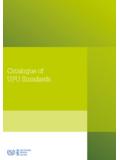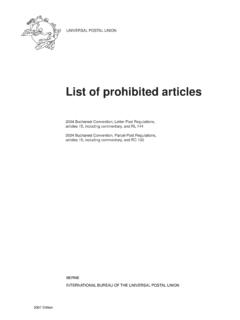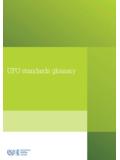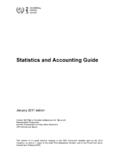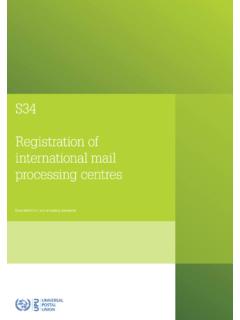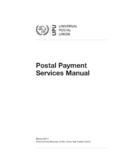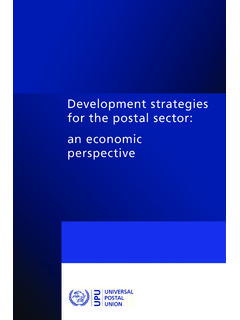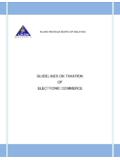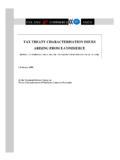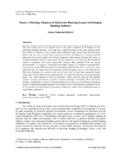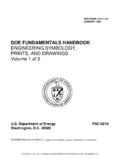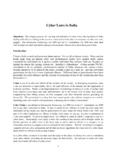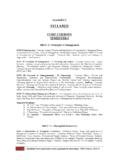Transcription of An introduction to postal EDI exchanges
1 an introduction to postal edi exchanges UPU 2013 All rights reserved i Date of approval of this version: 9 April 2013 an introduction to postal edi exchanges UPU standards are updated in their entirety. Each update results in a new version, indicated by the version number following the number of the standard. Before using this document, please check in the Catalogue of UPU Standards that it is still valid. The Catalogue is freely available on the UPU website at ii UPU 2013 All rights reserved Disclaimer This document contains the latest information available at the time of publication. The Universal postal Union offers no warrants, express or implied, regarding the accuracy, sufficiency, merchantability or fitness for any purpose of the information contained herein.
2 Any use made thereof is entirely at the risk and for the account of the user. Warning intellectual property The Universal postal Union draws attention to the possibility that the implementation of this standard might involve the use of a claimed intellectual property right. Recipients of this document are invited to submit, with their comments, notification of any relevant rights of which they are aware and to provide supporting documentation. As of the date of approval of this standard, the Universal postal Union had not received such notice of any intellectual property which might be required to implement this standard, other than what is indicated in this publication.
3 Nevertheless, the Universal postal Union disowns any responsibility concerning the existence of intellectual property rights of third parties, embodied fully or partly, in this Universal postal Union standard. Copyright notice UPU, 2013. All rights reserved. This document is copyright-protected by the UPU. While its reproduction for use by participants in the UPU standards development process is permitted without prior permission from the UPU, neither this document nor any extract from it may be reproduced, stored or transmitted in any form for any other purpose without prior written permission from the UPU.
4 Requests for permission to reproduce this document for other purposes should be addressed to: Universal postal Union Standards Programme Box 312 3000 BERNE 15 SWITZERLAND Tel: +41 31 350 3111 Fax: +41 31 350 3110 E-mail: Reproduction for sales purposes may be subject to royalty payments or a licensing agreement. UPU 2013 All rights reserved iii Contents Foreword .. iv 1 introduction .. 1 2 What is EDI? .. 1 3 What is EDIFACT? .. 1 4 What is XML? .. 3 5 Format of postal EDI messages: EDIFACT, XML or both? .. 4 6 postal EDI messages: a short history .. 4 7 What are EDI messages used for today? .. 5 8 Who defines postal EDI standards?
5 6 9 How are EDI standards implemented in an IT solution? .. 7 10 What is an EDI network? .. 7 11 What is an EDI address? .. 8 12 How to navigate through a UPU EDI messaging standard document .. 9 Table of contents .. 9 Data structure .. 10 Business data elements .. 11 Branching diagram .. 12 EDIFACT segments table .. 13 EDIFACT message specification .. 13 Conclusion .. 14 13 How can EDI exchanges be started and monitored? .. 14 14 What are code lists? .. 15 15 Where can more information be found? .. 16 Bibliography .. 17 iv UPU 2013 All rights reserved Foreword postal services form part of the daily life of people all over the world.
6 The Universal postal Union (UPU) is the specialised agency of the United Nations that regulates the universal postal service. The postal services of its 192 member countries form the largest physical distribution network in the world. More than 5 million postal employees working in over 660 000 post offices all over the world handle an annual total of 434 billion letter-post items in the domestic service and 5,5 billion in the international service. More than 6 billion parcels are sent by post annually. Keeping pace with the changing communications market, postal operators are increasingly using new communication and information technologies to move beyond what is traditionally regarded as their core postal business.
7 They are meeting higher customer expectations with an expanded range of products and value-added services. Standards are important prerequisites for effective postal operations and for interconnecting the global network. The UPU's Standards Board develops and maintains a growing number of standards to improve the exchange of postal -related information between postal operators and promotes the compatibility of UPU and international postal initiatives. It works closely with postal handling organisations, customers, suppliers and other partners, including various international organisations.
8 The Standards Board ensures that coherent standards are developed in areas such as electronic data interchange (EDI), mail encoding, postal forms and meters. UPU standards are drafted in accordance with the rules set out in Part V of the "General information on UPU standards" and are published by the UPU International Bureau in accordance with Part VII of that publication. UPU 2013 All rights reserved 1 an introduction to postal edi exchanges 1 introduction This document provides general information about postal EDI exchanges . It begins with basic details and progresses into more sophisticated concepts.
9 It also describes common practices in EDI exchanges . This document has been written for newcomers to postal EDI. These include technical providers who may not be familiar with the postal world, as well as anybody involved in the implementation, monitoring or maintenance of postal EDI exchanges . This document assumes some knowledge of postal processes. Readers without any postal background whatsoever would benefit by first learning the basics of the international mail process and learning the meaning of terms like mail item, receptacle, despatch, consignment, and so on. 2 What is EDI? EDI stands for Electronic Data Interchange.
10 It is a generic acronym that covers the electronic exchange of data, usually between different parties. Many industries exchange data through EDI networks. They use standards like EDIFACT (see next section). For example, EDI networks routinely link car manufacturers with subcontractors and enable all parties to communicate and exchange data efficiently. Each car manufacturer exchanges data with many subcontractors and each subcontractor may work for several car manufacturers; the EDI network facilitates exchanges by providing a single communication channel for all parties.
